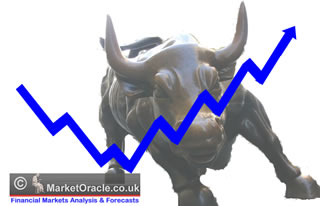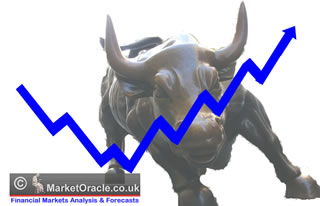Why ETFs Beat Mutual Funds Investing By a Mile
InvestorEducation / Exchange Traded Funds May 07, 2009 - 09:22 AM GMT Ron Rowland writes: I’ve been trading and investing in mutual funds for most of my life, and I’ve had some success. Yet I have to admit that mutual funds have some shortcomings as an investment vehicle. I’ll bet you’ve noticed the same things, too …
Ron Rowland writes: I’ve been trading and investing in mutual funds for most of my life, and I’ve had some success. Yet I have to admit that mutual funds have some shortcomings as an investment vehicle. I’ll bet you’ve noticed the same things, too …
![]() Limited Liquidity. You can only buy and sell mutual funds at the end of the day. Even worse, you don’t know the price until after you’re already committed. How crazy is that?
Limited Liquidity. You can only buy and sell mutual funds at the end of the day. Even worse, you don’t know the price until after you’re already committed. How crazy is that?
![]() Exorbitant Fees. In a stock fund it’s common to pay out 1.5 percent of your hard-earned capital every year to a manager who — to put it kindly — probably isn’t missing any meals. And that doesn’t count the “loads” and “advisory fees” that go to the broker or financial planner who helps you select your funds.
Exorbitant Fees. In a stock fund it’s common to pay out 1.5 percent of your hard-earned capital every year to a manager who — to put it kindly — probably isn’t missing any meals. And that doesn’t count the “loads” and “advisory fees” that go to the broker or financial planner who helps you select your funds.
 |
| The big fees you pay a mutual fund manager can eat into your returns. And that manager probably isn’t missing any meals. |
![]() Information Gap. When you buy a mutual fund, you have no idea what you’re getting. Managers are only required to disclose their holdings twice a year, usually with a 30-60 day delay. A few are generous and give out monthly updates. As far as I’m concerned, this is absolutely ridiculous in today’s fast-moving markets.
Information Gap. When you buy a mutual fund, you have no idea what you’re getting. Managers are only required to disclose their holdings twice a year, usually with a 30-60 day delay. A few are generous and give out monthly updates. As far as I’m concerned, this is absolutely ridiculous in today’s fast-moving markets.
See the problem?
Mutual funds were a fantastic idea in the beginning, back when it was hard for individual investors to build their own stock portfolios. Like many good ideas, they had their day. Now a new generation is taking the lead. So do you want to stay out front? Then you need to learn about ETFs.
SPY: The First ETF
Back in the 1980s, index investing started becoming popular. More than a few people were doubtful about the ability of mutual fund managers to “beat the market” over long periods of time. And if you can’t beat the market, why not just buy the market?
Back then Vanguard dominated the index fund business. But their funds still had limitations — especially if you wanted to buy and sell frequently. So along came a Spider.
In 1993 the American Stock Exchange introduced the “S&P Depository Receipt,” affectionately called the SPDR. The idea was simple yet revolutionary. The SPDR was basically a stock that owned other stocks — in this case, all 500 companies that make up the S&P 500 Index.
Want to jump into the S&P 500? Shazam! With the S&P 500 SPDR, all it took was one trade, any time the stock market was open. No need to wait until the end of the day. Suddenly it became possible for anyone to buy or sell the index — on their own schedule, not Vanguard’s.
Moreover, the SPDR had rock-bottom fees that were competitive with even the cheapest index funds. Online trading was starting to take off, too, so brokerage commissions were coming down fast. It was the perfect storm.
This first ETF is still around today. The ticker symbol is SPY and it remains the largest, most actively-traded ETF. Soon more SPDR funds were launched to track other indexes.
In 1996 Barclays Global Investors opened a family of international ETFs called WEBS — World Equity Benchmark Shares. Later they changed the brand name to iShares.
As the ETF business grew, other players joined the fray: Companies like PowerShares, ProShares, Claymore, Direxion, and more. Even Vanguard now has an extensive lineup of ETFs.
 |
| In 1996 Barclays Global Investors opened their World Equity Benchmark Shares. Later they changed the brand name to iShares. |
It’s not hard to see why ETFs are now the hottest business on Wall Street, attracting untold billions in assets. Everyone wants a piece of the action, which is why there are now more than 800 exchange-traded products like ETFs. Hundreds more are now in the SEC registration process. Even the bear market isn’t slowing down the trend.
Hidden Genius: ETF Arbitrage
What made SPY so revolutionary was a unique design feature that keeps its market price in line with the value of the underlying stocks. Unlike closed-end mutual funds, where the share price can trade at a dramatic discount or premium to its actual worth, ETFs stick very close to their net asset value.
How do they do this? It’s all in the plumbing. Institutional investors can “create” and “redeem” shares of ETFs in exchange for the underlying portfolio stocks. This creates an arbitrage opportunity. If the price of an ETF drifts too far above or below its actual value, professional traders will usually push it back into line very quickly.
 |
| Behind the scenes, professional traders keep the market price of ETFs in line with the value of the underlying stocks. |
This all happens behind the scenes, and you don’t have to think about it. Do you still have to be careful when you’re buying or selling an ETF? Of course. But ETFs are designed from the ground up to give you a fair deal. That’s more than you can say for many mutual funds.
ETFs Win By a Mile!
So in contrast to mutual funds, ETFs offer investors plenty of advantages, including three huge ones …
- ETFs are Liquid! You can buy or sell an ETF in a regular brokerage account anytime the markets are open. You can also use special techniques like stop-loss and limit orders, and you can see the latest quoted price in real-time on many financial information services. ETFs are Inexpensive! Almost all ETFs have fees of less than 1 percent a year, and most are much less. A few are almost negligible. SPY, for instance, has annualized net expenses of only 0.09 percent, and a few Vanguard ETFs are pegged even lower at 0.07 percent.
- ETFs are Transparent! You’ll always know what you are getting when you buy an ETF, because they are based on publicly available market indexes. So you don’t have to wonder if your ETF owns something you didn’t know about.
Now, you can see why I like ETFs so much!
Sure, I still suggest mutual funds every now and then, but ETFs are the present … and the future. And that’s why I’ll devote a lot of space to them in future Money and Markets issues. So stay tuned!
Best wishes,
Ron
This investment news is brought to you by Money and Markets . Money and Markets is a free daily investment newsletter from Martin D. Weiss and Weiss Research analysts offering the latest investing news and financial insights for the stock market, including tips and advice on investing in gold, energy and oil. Dr. Weiss is a leader in the fields of investing, interest rates, financial safety and economic forecasting. To view archives or subscribe, visit http://www.moneyandmarkets.com .
Money and Markets Archive |
© 2005-2022 http://www.MarketOracle.co.uk - The Market Oracle is a FREE Daily Financial Markets Analysis & Forecasting online publication.



